Page 454 of 745
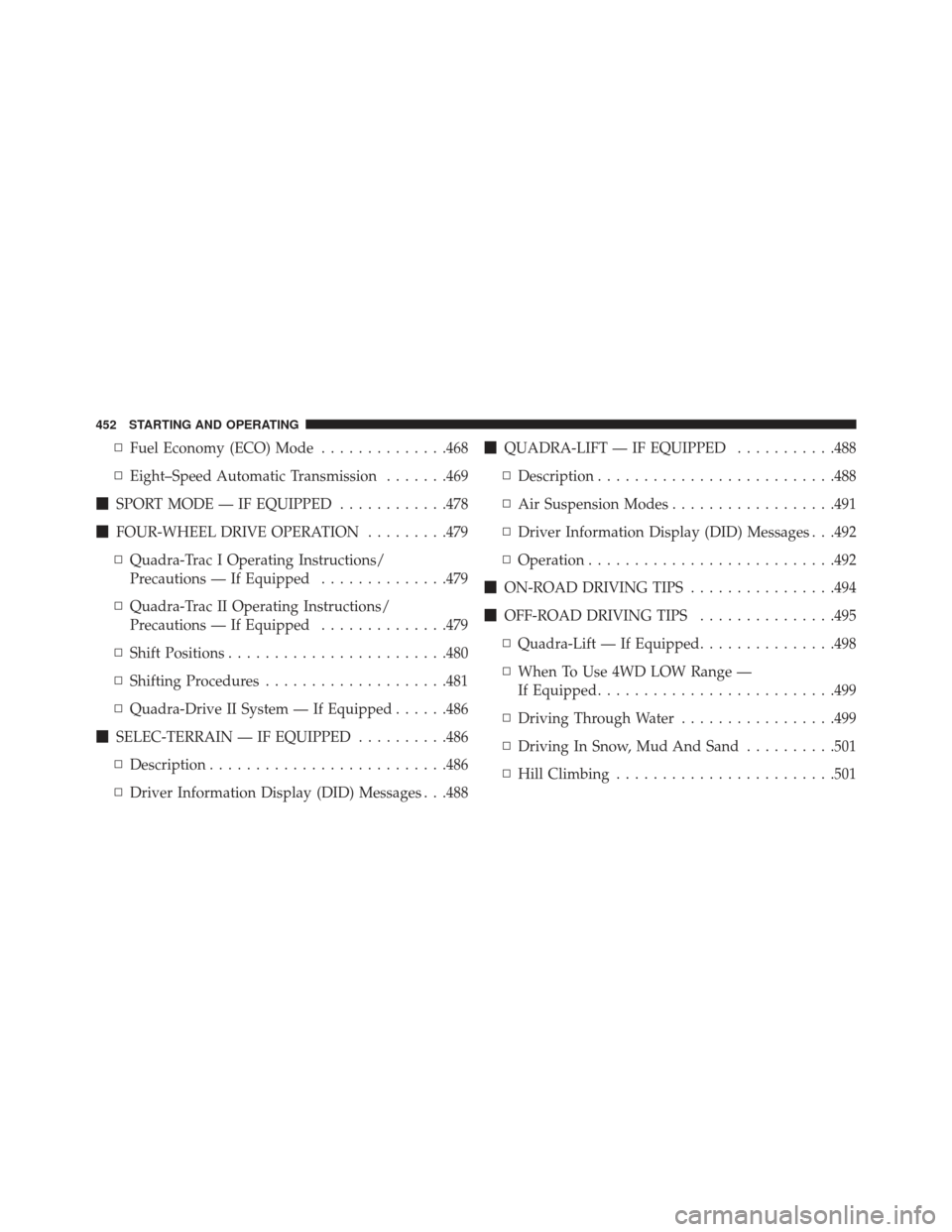
▫Fuel Economy (ECO) Mode ..............468
▫ Eight–Speed Automatic Transmission .......469
� SPORT MODE — IF EQUIPPED ............478
� FOUR-WHEEL DRIVE OPERATION .........479
▫ Quadra-Trac I Operating Instructions/
Precautions — If Equipped ..............479
▫ Quadra-Trac II Operating Instructions/
Precautions — If Equipped ..............479
▫ Shift Positions ....................... .480
▫ Shifting Procedures ....................481
▫ Quadra-Drive II System — If Equipped ......486
� SELEC-TERRAIN — IF EQUIPPED ..........486
▫ Description ......................... .486
▫ Driver Information Display (DID) Messages . . .488 �
QUADRA-LIFT — IF EQUIPPED ...........488
▫ Description ......................... .488
▫ Air Suspension Modes ..................491
▫ Driver Information Display (DID) Messages . . .492
▫ Operation .......................... .492
� ON-ROAD DRIVING TIPS ................494
� OFF-ROAD DRIVING TIPS ...............495
▫ Quadra-Lift — If Equipped ...............498
▫ When To Use 4WD LOW Range —
If Equipped ......................... .499
▫ Driving Through Water .................499
▫ Driving In Snow, Mud And Sand ..........501
▫ Hill Climbing ....................... .501
452 STARTING AND OPERATING
Page 458 of 745
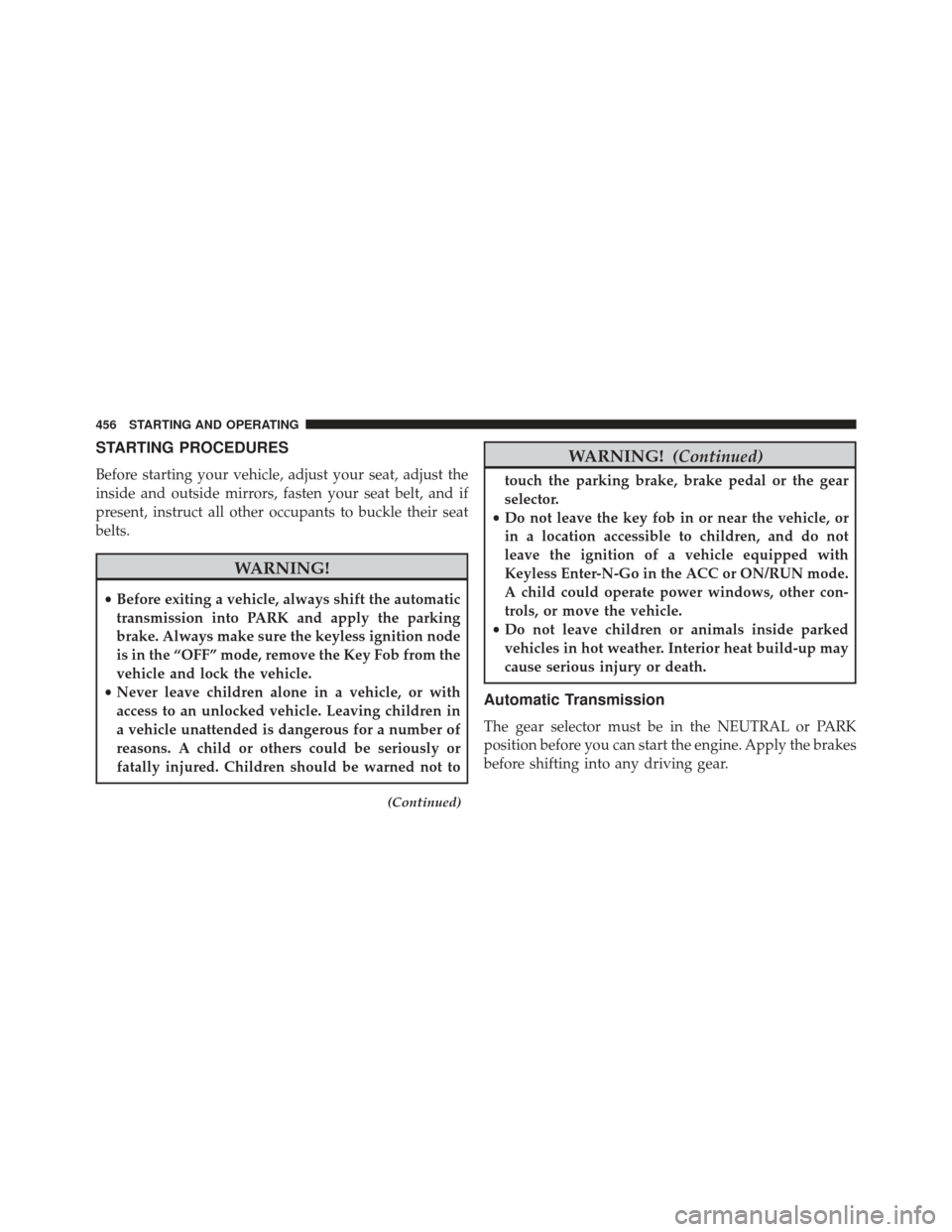
STARTING PROCEDURES
Before starting your vehicle, adjust your seat, adjust the
inside and outside mirrors, fasten your seat belt, and if
present, instruct all other occupants to buckle their seat
belts.
WARNING!
•Before exiting a vehicle, always shift the automatic
transmission into PARK and apply the parking
brake. Always make sure the keyless ignition node
is in the “OFF” mode, remove the Key Fob from the
vehicle and lock the vehicle.
• Never leave children alone in a vehicle, or with
access to an unlocked vehicle. Leaving children in
a vehicle unattended is dangerous for a number of
reasons. A child or others could be seriously or
fatally injured. Children should be warned not to
(Continued)
WARNING! (Continued)
touch the parking brake, brake pedal or the gear
selector.
• Do not leave the key fob in or near the vehicle, or
in a location accessible to children, and do not
leave the ignition of a vehicle equipped with
Keyless Enter-N-Go in the ACC or ON/RUN mode.
A child could operate power windows, other con-
trols, or move the vehicle.
• Do not leave children or animals inside parked
vehicles in hot weather. Interior heat build-up may
cause serious injury or death.
Automatic Transmission
The gear selector must be in the NEUTRAL or PARK
position before you can start the engine. Apply the brakes
before shifting into any driving gear.
456 STARTING AND OPERATING
Page 460 of 745

3. The system takes over and attempts to start thevehicle. If the vehicle fails to start, the starter will
disengage automatically after 10 seconds.
4. If you wish to stop the cranking of the engine prior to the engine starting, push the button again.
NOTE: Normal starting of either a cold or a warm engine
is obtained without pumping or pressing the accelerator
pedal.
To Turn Off The Engine Using ENGINE
START/STOP Button
1. Place the gear selector in PARK, then push and release the ENGINE START/STOP button.
2. The ignition switch will return to the OFF position.
3. If the gear selector is not in PARK, the ENGINE START/STOP button must be held for two seconds or
three short pushes in a row with the vehicle speed above 5 mph (8 km/h) before the engine will shut off.
The ignition switch position will remain in the ACC
position until the gear selector is in PARK and the
button is pushed twice to the OFF position. If the gear
selector is not in PARK and the ENGINE START/
STOP button is pushed once, the Driver Information
Display (DID) will display a “Vehicle Not In Park”
message and the engine will remain running. Never
leave a vehicle out of the PARK position, or it could
roll.
NOTE: If the ignition switch is left in the ACC or RUN
(engine not running) position and the transmission is in
PARK, the system will automatically time out after 30
minutes of inactivity and the ignition will switch to the
OFF position.
458 STARTING AND OPERATING
Page 465 of 745

•Steering angle beyond threshold.
• ACC is on and speed is set.
It may be possible for the vehicle to be driven several
times without the STOP/START system going into a
STOP/START READY state under more extreme condi-
tions of the items listed above.
To Start The Engine While In Autostop Mode
While in a forward gear, the engine will start when the
brake pedal is released or the throttle pedal is depressed.
The transmission will automatically re-engage upon en-
gine restart. Conditions That Will Cause The Engine To Start Auto-
matically While In Autostop Mode:
•
The transmission selector is moved out of DRIVE.
• To maintain cabin temperature comfort.
• HVAC is set to full defrost mode.
• HVAC system temperature or fan speed is manually
adjusted.
• Battery voltage drops too low.
• Low brake vacuum (e.g. after several brake pedal
applications).
• STOP/START OFF switch is pressed.
• A STOP/START system error occurs.
• 4WD system is put into 4LO mode.
5
STARTING AND OPERATING 463
Page 467 of 745
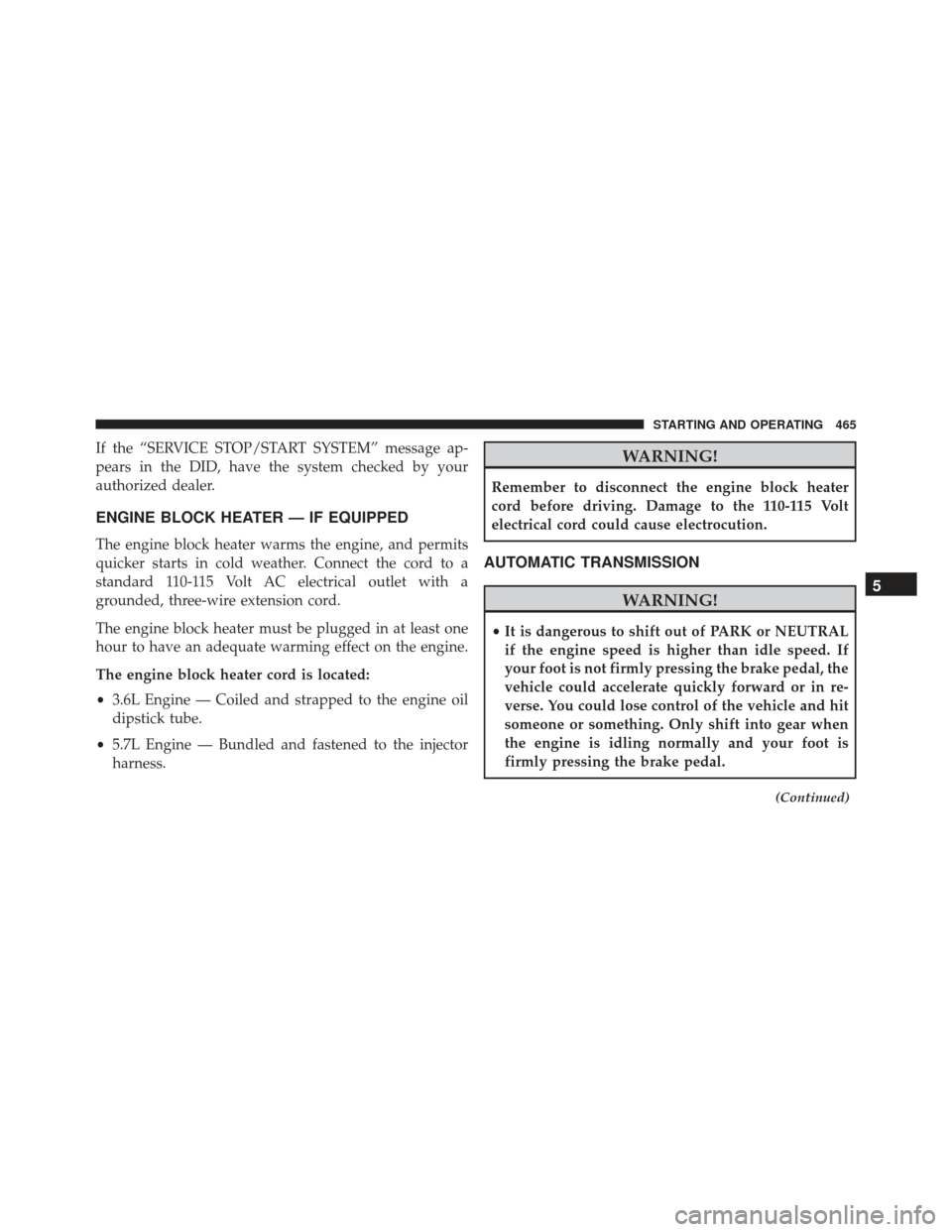
If the “SERVICE STOP/START SYSTEM” message ap-
pears in the DID, have the system checked by your
authorized dealer.
ENGINE BLOCK HEATER — IF EQUIPPED
The engine block heater warms the engine, and permits
quicker starts in cold weather. Connect the cord to a
standard 110-115 Volt AC electrical outlet with a
grounded, three-wire extension cord.
The engine block heater must be plugged in at least one
hour to have an adequate warming effect on the engine.
The engine block heater cord is located:
•3.6L Engine — Coiled and strapped to the engine oil
dipstick tube.
• 5.7L Engine — Bundled and fastened to the injector
harness.
WARNING!
Remember to disconnect the engine block heater
cord before driving. Damage to the 110-115 Volt
electrical cord could cause electrocution.
AUTOMATIC TRANSMISSION
WARNING!
• It is dangerous to shift out of PARK or NEUTRAL
if the engine speed is higher than idle speed. If
your foot is not firmly pressing the brake pedal, the
vehicle could accelerate quickly forward or in re-
verse. You could lose control of the vehicle and hit
someone or something. Only shift into gear when
the engine is idling normally and your foot is
firmly pressing the brake pedal.
(Continued)
5
STARTING AND OPERATING 465
Page 471 of 745

Active Noise Cancellation — Summit And SRT
Models Only
Your vehicle is equipped with an Active Noise Cancella-
tion System. This system uses four microphones embed-
ded in the headliner to detect undesirable exhaust noise,
which sometimes occurs when operating in ECO mode.
An onboard frequency generator creates counteracting
sound waves through the audio system to help keep the
vehicle quiet.
Eight–Speed Automatic Transmission
The transmission gear range (PRNDM) is displayed both
on the gear selector bezel and in the Driver Information
Display (DID). To select a gear range, press the lock
button on the gear selector and move the lever rearward
or forward. You must also press the brake pedal to shift
the transmission out of PARK, or to shift from NEUTRAL
into DRIVE or REVERSE when the vehicle is stopped ormoving at low speeds (refer to “Brake/Transmission
Shift Interlock System” in this section). Select the DRIVE
range for normal driving.
The electronically-controlled transmission provides a
precise shift schedule. The transmission electronics are
self-calibrating; therefore, the first few shifts on a new
vehicle may be somewhat abrupt. This is a normal
condition, and precision shifts will develop within a few
hundred miles (kilometers).
Only shift from DRIVE to PARK or REVERSE when the
accelerator pedal is released and the vehicle is stopped.
Be sure to keep your foot on the brake pedal when
shifting between these gears.
The transmission gear selector provides PARK, RE-
VERSE, NEUTRAL, DRIVE and MANUAL (AutoStick)
shift positions. Manual shifts can be made using the
AutoStick shift control (refer to “AutoStick” in this
5
STARTING AND OPERATING 469
Page 476 of 745
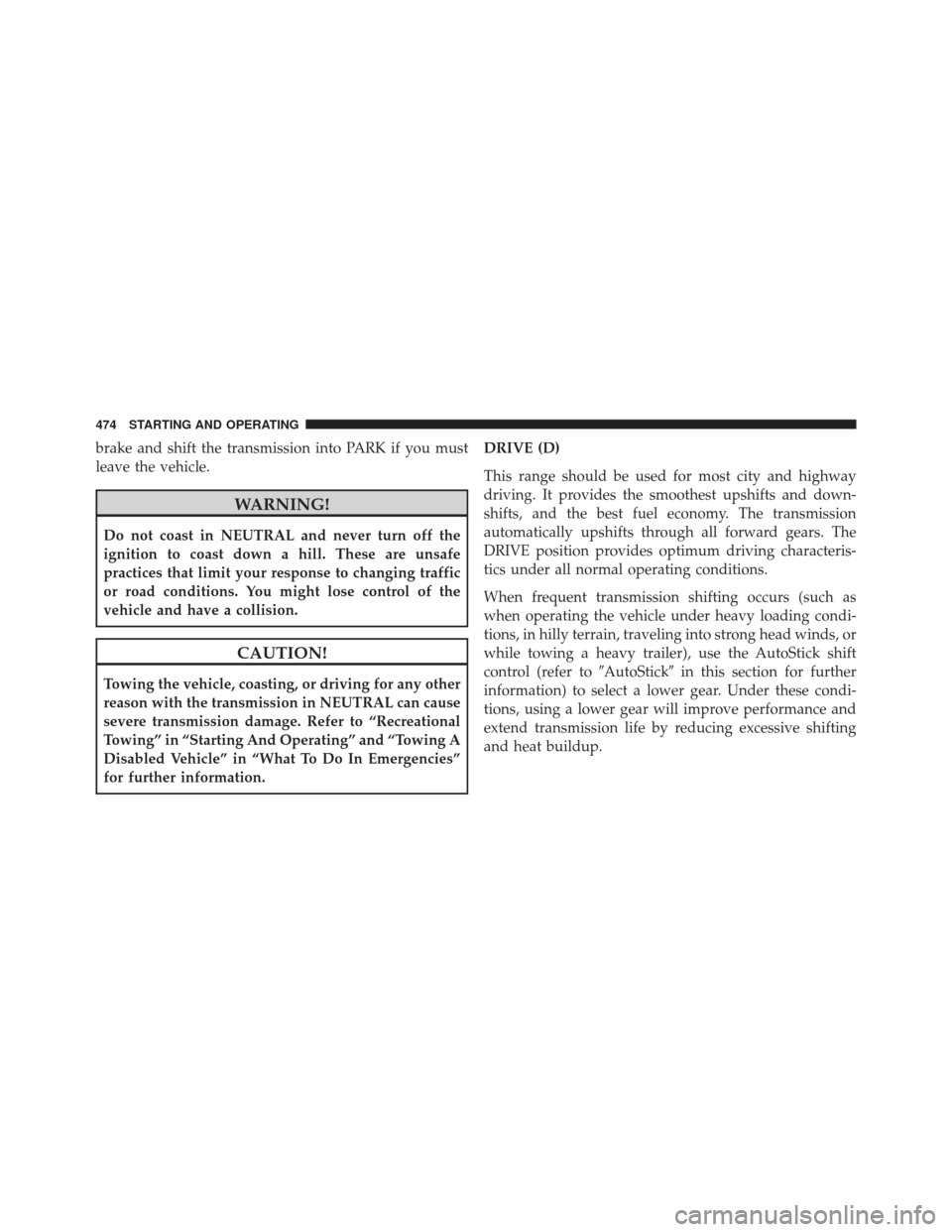
brake and shift the transmission into PARK if you must
leave the vehicle.
WARNING!
Do not coast in NEUTRAL and never turn off the
ignition to coast down a hill. These are unsafe
practices that limit your response to changing traffic
or road conditions. You might lose control of the
vehicle and have a collision.
CAUTION!
Towing the vehicle, coasting, or driving for any other
reason with the transmission in NEUTRAL can cause
severe transmission damage. Refer to “Recreational
Towing” in “Starting And Operating” and “Towing A
Disabled Vehicle” in “What To Do In Emergencies”
for further information.DRIVE (D)
This range should be used for most city and highway
driving. It provides the smoothest upshifts and down-
shifts, and the best fuel economy. The transmission
automatically upshifts through all forward gears. The
DRIVE position provides optimum driving characteris-
tics under all normal operating conditions.
When frequent transmission shifting occurs (such as
when operating the vehicle under heavy loading condi-
tions, in hilly terrain, traveling into strong head winds, or
while towing a heavy trailer), use the AutoStick shift
control (refer to
�AutoStick�in this section for further
information) to select a lower gear. Under these condi-
tions, using a lower gear will improve performance and
extend transmission life by reducing excessive shifting
and heat buildup.
474 STARTING AND OPERATING
Page 479 of 745
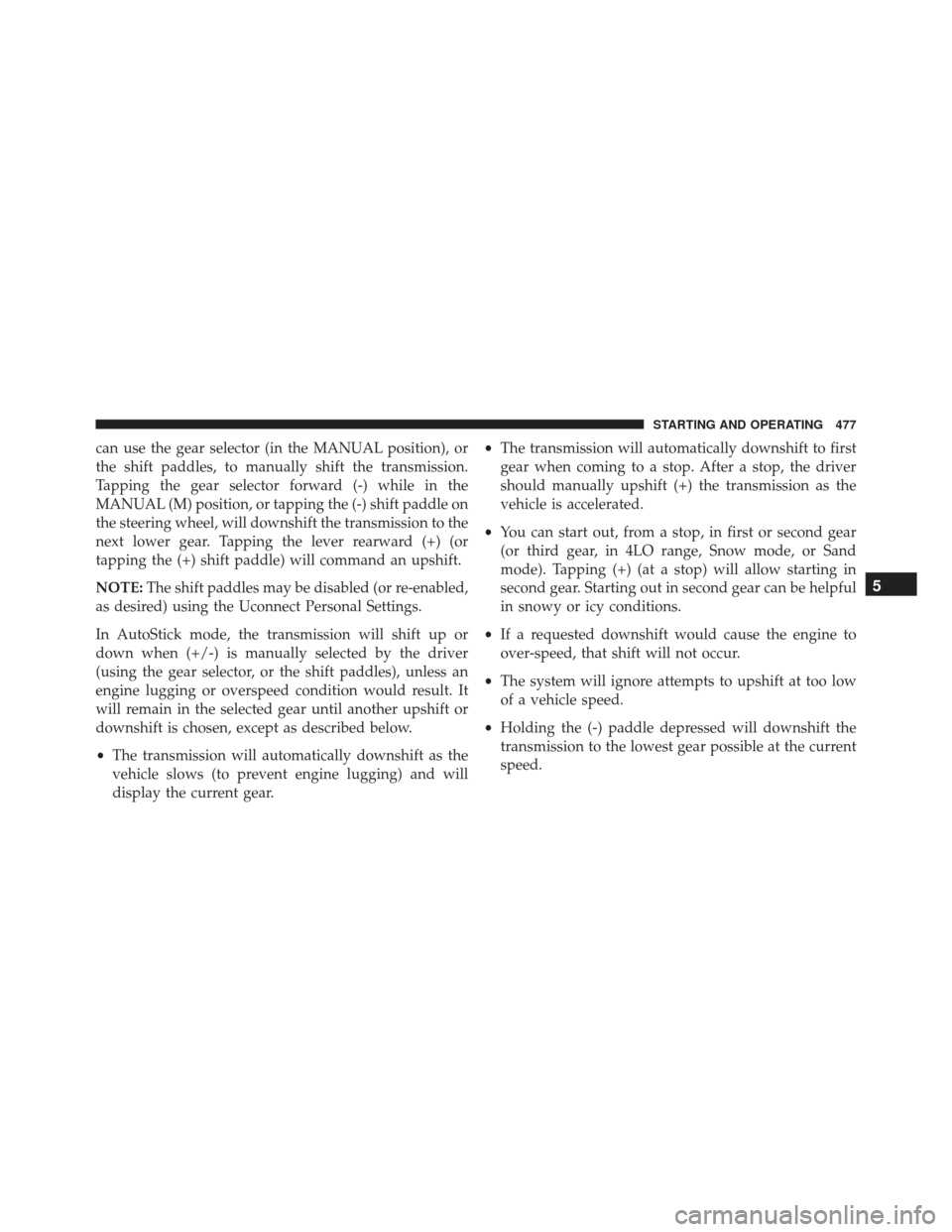
can use the gear selector (in the MANUAL position), or
the shift paddles, to manually shift the transmission.
Tapping the gear selector forward (-) while in the
MANUAL (M) position, or tapping the (-) shift paddle on
the steering wheel, will downshift the transmission to the
next lower gear. Tapping the lever rearward (+) (or
tapping the (+) shift paddle) will command an upshift.
NOTE:The shift paddles may be disabled (or re-enabled,
as desired) using the Uconnect Personal Settings.
In AutoStick mode, the transmission will shift up or
down when (+/-) is manually selected by the driver
(using the gear selector, or the shift paddles), unless an
engine lugging or overspeed condition would result. It
will remain in the selected gear until another upshift or
downshift is chosen, except as described below.
• The transmission will automatically downshift as the
vehicle slows (to prevent engine lugging) and will
display the current gear. •
The transmission will automatically downshift to first
gear when coming to a stop. After a stop, the driver
should manually upshift (+) the transmission as the
vehicle is accelerated.
• You can start out, from a stop, in first or second gear
(or third gear, in 4LO range, Snow mode, or Sand
mode). Tapping (+) (at a stop) will allow starting in
second gear. Starting out in second gear can be helpful
in snowy or icy conditions.
• If a requested downshift would cause the engine to
over-speed, that shift will not occur.
• The system will ignore attempts to upshift at too low
of a vehicle speed.
• Holding the (-) paddle depressed will downshift the
transmission to the lowest gear possible at the current
speed.
5
STARTING AND OPERATING 477